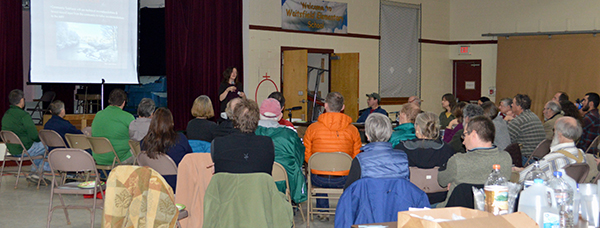Municipal leaders heard funding requests from local nonprofits and other agencies including a request for increased staffing of the Mad River Valley Planning District as well additional funding for the Mad River Valley Rec District at a recent leadership summit.
At the December 9 meeting organizations presented their current work with stormwater, solid waste, recreation and planning at the Mad River Valley town leadership meeting, held at Waitsfield Elementary School.
PLANNING FOR THE FUTURE
Planning district chair Bob Ackland explained the work of this summer’s Economic Vitality Workshops which were developed to study economic patterns with a set of rigorous data, and then recommend initiatives that support future financial success. Ackland said that community feedback from a long series of forums revealed that “recreation was the number one priority” for business owners and community members.
Food production, access to affordable land and housing, education and transportation are all topics that cropped up in relation to economic vitality, and the results of the study will be presented at the 2015 MRV Economic Summit on December 17 at Sugarbush’s Gate House Lodge at 5 p.m.
Ackland also discussed the vision of the planning district, which works on municipal planning support, Valleywide projects, Sugarbush development and recently the economic vitality study and implementation mentioned above. “That’s a lot of work for one and a half people,” he said.
The district is hoping to fund a second position that would come with a $43,000 salary, and each town – Warren, Waitsfield and Fayston – would contribute an additional $10,800 to their current input, totaling $41,986 for the planning district next year.
The district collected and allocated $2.7 million in grants and loans between 2009 and 2015, all of which has gone to towns and organizations. Ackland asked towns to “step up and invest in the community – there’s no other way to say it.”
RECREATION IN THE VALLEY
Mark Kane and Drew Pollak of SE Group, a planning and design firm based in Montpelier, talked about a project that aims to create a more innovative and active transportation plan for The Valley. The project is being undertaken in collaboration with the Mad River Valley Planning District and is funded by VTrans, Vermont Agency of Commerce, towns of Waitsfield, Fayston, Moretown and Warren, and others.
Kane said that their community surveys found that “recreation and non-motorized transportation are almost the same thing” in The Valley, and the company is thinking more deeply into how these relate to each other and how that relationship could be strengthened.
Rebecca Baruzzi, president of the recreation district, which awards grants to the Mad River Park, Mad River Path, Mad River Riders, Mad River Valley Little League, and other recreational groups, requested that Valley towns increase their funding of the district to reach a total of $15,000. The new budget would reach $45,000 – $40,000 would be continued to be allocated for grants and $5,000 would provide pay for employees to create new projects and expand the vision of the district. “We’re trying to take on something that’s pretty substantial without any staff, and that doesn’t work,” said Baruzzi.
COLLABORATION FOR HEALTHIER WATER SYSTEMS
Director of Friends of the Mad River Corrie Miller presented a project that seeks to improve water quality – stormwater and flood resilience in particular – a task force called the Watershed-Wide Water Management Program (W3MP). The group is composed of representatives from select boards and planning commissions of Waitsfield, Fayston, Warren, Moretown and Duxbury, in collaboration with Friends of the Mad River.
The group received a $60,000 grant from the High Meadows Fund and will use it next year to plan for a long-term approach to water issues in The Valley. Next year, they will collect feedback from Valley community members and will create recommendations for future water management practice that aligns with statewide legislation.
THE COMPLEXITIES OF TRASH
Karen Horn of the Vermont League of Cities and Towns, a membership association of 246 cities and town in the state, told the audience, “I’m here to talk to you about garbage.” When the state passed the Universal Recycling Law in 2012, which bans disposal of recyclables beginning in July 2015 and food scraps by July 2020, Horn found issues with the implementation – that “one size does not fit all.”
Horn said that all towns agree to recycle, but “the way you get there varies considerably.” While larger towns find no problem with creating transfer stations and employing haulers for recyclable trash, it does not always run smoothly for smaller rural communities. Horn and her colleagues are asking for more flexibility with the legislation, and she said the more local officials that get involved, the better response The Valley will receive from the state.






